
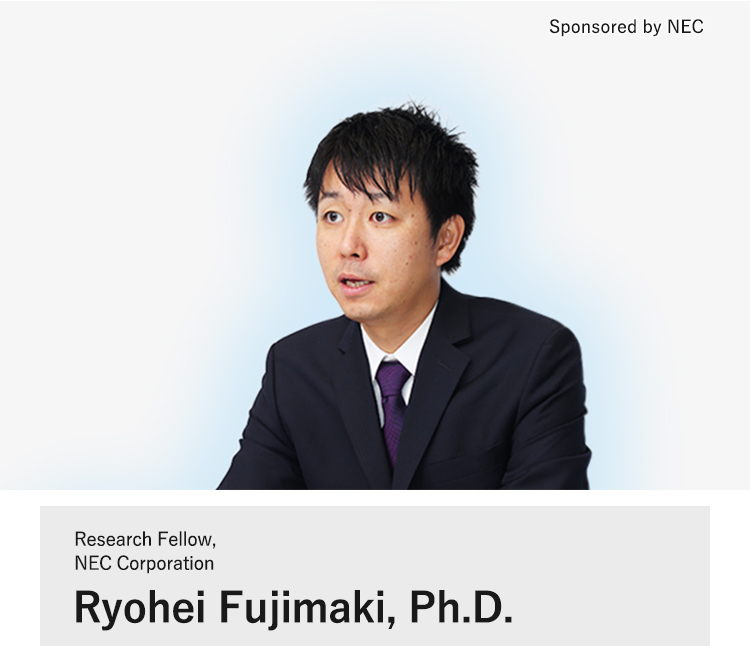


Big data, including business data and sensor data, is collected daily. Analyzing such large amounts of data quickly and deriving insights from it have become crucial business tasks.
Predictive Analytics has been gaining attention from leading companies around the world for the predictive models it has made possible on the basis of data analysis. Business opportunities will increase dramatically if the future can be predicted with higher accuracy. Applications such as anticipating customer behavior and predicting the malfunction of parts continue to increase in variety.
NEC announced late last year their development of Predictive Analysis Automation Technology, which is expected to be publicly available in 2017. This new technology utilizes the full range of its cutting edge AI technology group, NEC the WISE. Joint verification experiments carried out last year by Mitsui Sumitomo Banking Corporation (SMBC), the Japan Research Institute, and NEC confirmed that the new technology successfully reduced to just one day the time required for predictive analysis that had previously required two to three months at SMBC, while still maintaining or improving predictive accuracy.
This interview was held to better understand the potential impact and future prospects for the new technology with respect to business. We spoke to Dr. Ryohei Fujimaki, a young Research Fellow at NEC Corporation who has been involved in the development of Predictive Analysis Automation Technology.
Tell us about your work as a Research Fellow at NEC.

Ryohei Fujimaki, Ph.D.
Research Fellow,
NEC Corporation
Dr. Fujimaki I'm slightly uncomfortably dressed in a suit today, but normally I wear a t-shirt to work.
My research team is based in three locations: Japan, China, and the United States, where it is centered. I am also leading development teams in India, Europe, and Japan, and our client base is expanding from the U.S. to around the world. For that reason, I have a business trip once every two or three weeks, and I work on my research in all sorts of places.
While I myself specialize in machine learning algorithms, developing truly competitive technology takes more than just research in algorithms. Along with the development of basic principles, the most important task is to create a vision for technology and the marketplace by repeating market research and discussions with our users as well as core technology research. With such a vision, we can combine the strengths of our teams of experts, in a variety of specialties and from all over the world, in the development of new technologies.
Tell us about your newly introduced Predictive Analysis Automation Technology and about the impact you expect it to have, as well as about NEC's other particular technologies.
Dr. Fujimaki Predictive Analysis Automation Technology employs AI to automatically analyze business data collected within a company. It automatically creates predictive models that help resolve business issues. For example, if you can predict beforehand an expected customer base - what sort of persons are likely to purchase your products or services - you can more efficiently raise sales through advertising and promotional campaigns. There are other areas, as well, in which highly precise predictive analysis is becoming indispensable, such as in the prediction of supply and demand, which can help increase the accuracy of stocking and reduce shortages, and in the anticipation of parts breakdowns in factories.
Until recently, experienced data-scientists formulated hypotheses and created predictive models. This required, however, their maintaining huge amounts of data, creating features to determine what data to focus upon, tuning their machine learning algorithms, and repeated trial-and-error work. While data-scientists possess specialized knowledge in statistical mathematics, they still need months to create a single predictive model. Also, there is, to begin with, a worldwide shortage of skilled data-scientists, and it is far from easy for a customer to employ one.
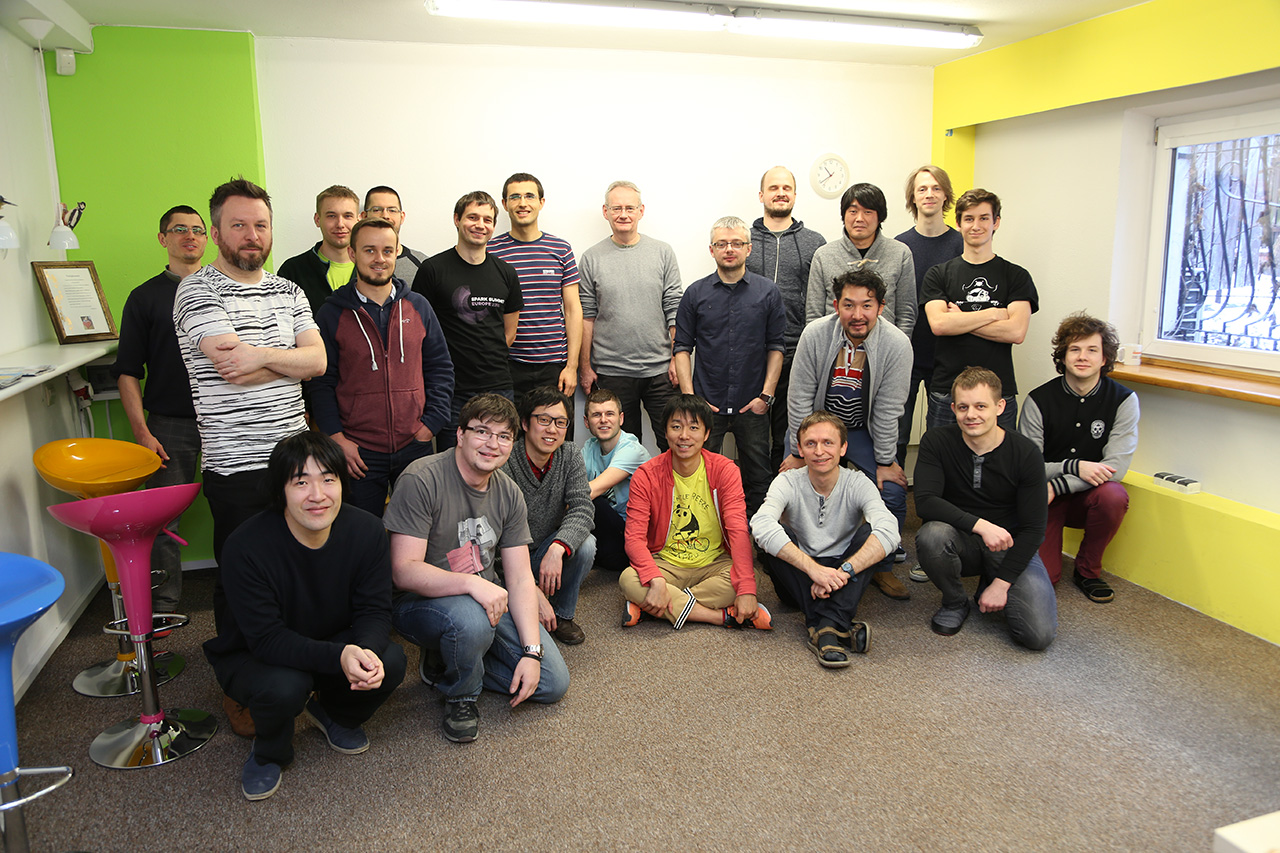
European Development Team

1: NEC's Predictive Analysis Automation
In today's corporate environment, which demands quick reaction to changes in the business world, the required development-time for predictive models is an extremely serious issue. That is why NEC has worked to develop its Feature Design Automation Technology and Predictive Model Automatic Design Technology as the core of Predictive Analysis Automation Technology.
Feature Design Automation Technology automatically designs features from relational databases widely utilized in business systems. It eliminates the need for the enormous tasks of formulating feature hypotheses that rely on experience in analysis and on knowledge of domain, and it makes is possible to greatly reduce the time and effort needed for analysis. Also, since a huge number of hypotheses searches, far beyond that which would be possible manually, is possible, it is also possible to increase the accuracy of analysis results and to discover new information that human analysts would fail to notice.
Predictive Model Automatic Design Technology selects, from among a large number of prediction models created using a variety of machine learning methods, that which will produce the best results for an individual user, or it combines models for the same purpose. With Predictive Analysis Automation Technology, then, the time required for data analysis can be reduced tremendously.
This can enhance the quality of customer management-strategies and quickly improve corporate value. In that sense, we believe that this technology has the potential to transform the role of data-scientists.
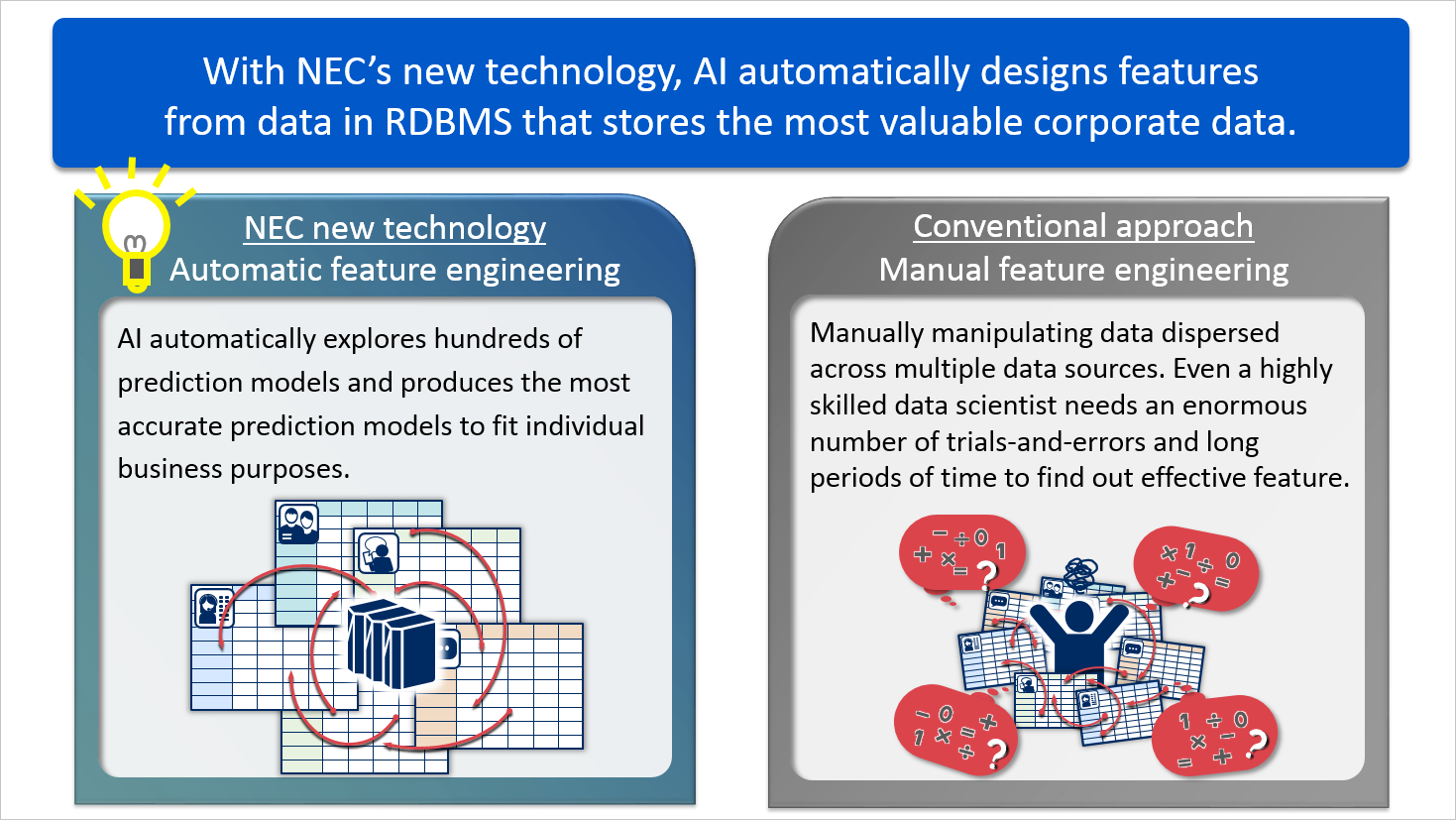
2: NEC's Feature Design Automation Technology
With the heavy demand today for data analysis, the shortage of data-scientists is a serious issue, isn't it?
Dr. Fujimaki As I mentioned earlier, companies want to identify potential customers. There is also a need to identify those customers who may become disaffected and discontinue usage, who may cancel their contracts. They also need to be able to predict what sorts of persons might be likely to become high-quality customers, that is, might be expected to come to represent increased customer loyalty. With such a high demand for models, there is a need to provide a greater number of data-scientists. This may not yet have become a conspicuous issue in Japan, but I believe human-resource shortages will create more acute problems in the future.
The securing of well-trained data scientists has already begun in the U.S., and ensuring the services of superior analysts is a management issue. In response to the data-scientist shortage, business analysts and data-engineers have also begun to analyze data, and they are known as "citizen data-scientists". We believe that the use of Predictive Analysis Automation Technology will make it possible for such "citizen data-scientists" to create predictive-analysis models equal to or more accurate than those of well-trained data scientists and that this will eventually help overcome the personnel shortage.
What are the strengths of NEC's Predictive Analysis Automation Technology? What makes it so special?
Dr. Fujimaki The class of machine learning methods known as "deep learning" has recently attracted wide attention, particularly given its use in the AlphaGo AI program developed by Alphabet Inc.'s Google DeepMind. "Deep learning" is a generic name for types of machine learning that employ neural networks and their peripheral technologies. The greatest strength of our technology is that it automatically determines features and creates predictive models from relational data contained in business databases. This cannot be done by other existing technologies, including deep learning.
In addition, although deep learning represents a breakthrough in the accuracy of its predictions in certain specific fields, it is said to be a "black box" in that it is unable to explain the reasons for the results it produces. When models are to be used by businesses, however, or in governmental predictions made in the public interest, there is the need to answer the question of why predictions have been made. In this regard, it is notable that Predictive Analysis Automation Technology makes it possible to visualize feature quantities automatically designed with AI and the predictive models that incorporate them, and it also is able to show what sort of logic led to the creation of a model. Also, this clarifies what kind of logic the model is derived from. This is known as "white box" AI, and it is one of the unique features of our technology.
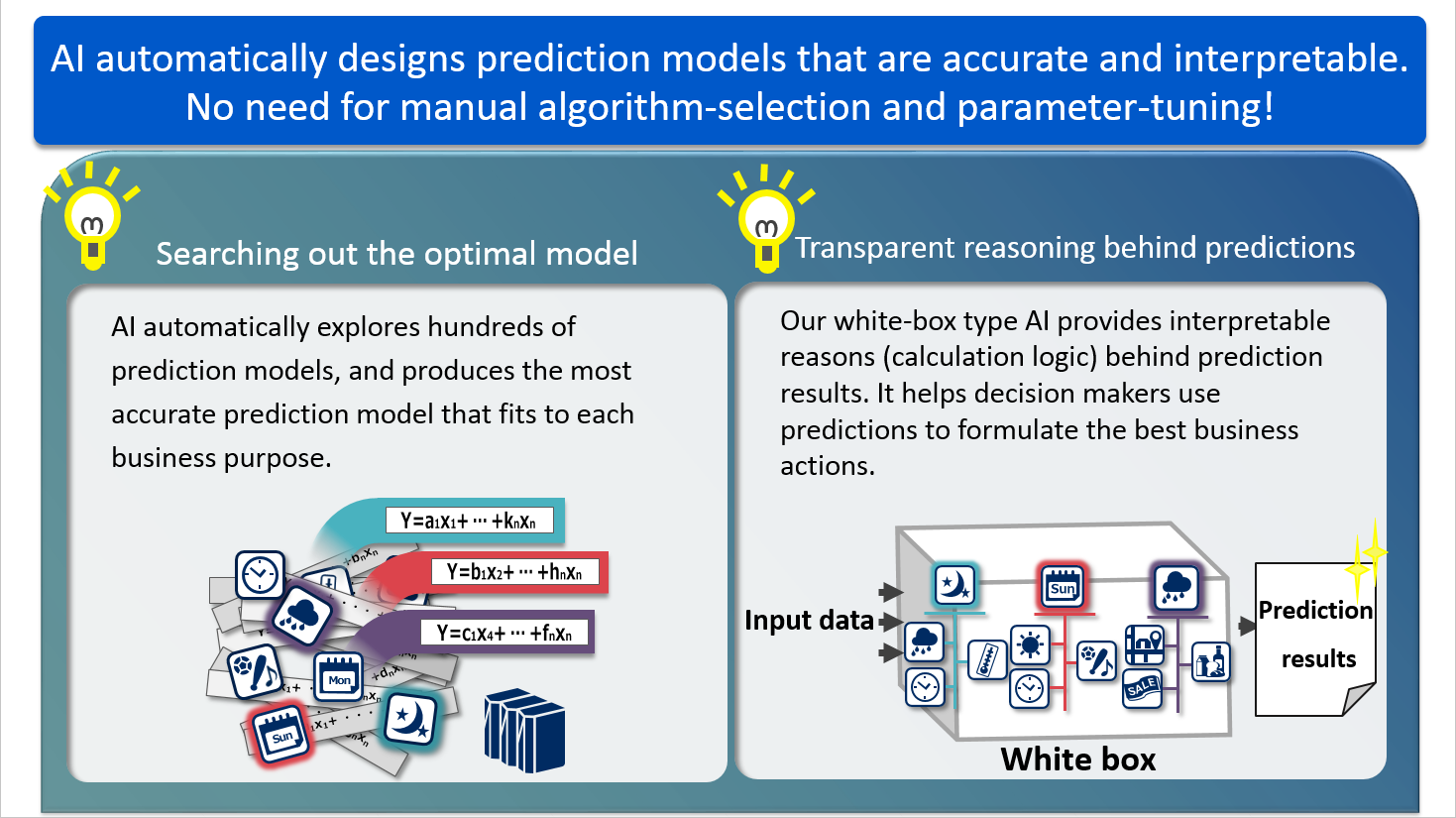
3: NEC's Predictive Model Automatic Design Technology
What has motivated NEC to make its Predictive Analysis Automation Technology widely available in the marketplace?
Dr. Fujimaki NEC has been active in proposing a variety of predictive- analysis-based solutions to such issues as automatic ordering by convenience store outlets and preventive maintenance in manufacturing plants. Conventionally, models have been created on the basis of customer-data analyzed by NEC. Our automation of predictive analysis grew from our original research and development efforts to improve the efficiency of analysis within NEC.
Meanwhile, data analysis has become so important as to influence the growth of companies, and a number of customers have established their own analysis departments. This new movement toward advanced in-house analysis represents a particularly significant change. Just as it has been difficult for us to create high-accuracy predictive models, however, it is certainly far from easy for companies' in-house personnel. This seemed to present us with an opportunity, and we determined to introduce into the marketplace our technology as a platform by which customers themselves might be able to perform high-level predictive analysis.
Tell us more about your previously mentioned joint verification experiments with Sumitomo Mitsui Banking Corporation (SMBC) and the Japan Research Institute.
Dr. Fujimaki We considered a number of subjects of interest in our verification experiments, such as what sort of customers would be likely to buy SMBC financial products. With respect to those subjects, SMBC had previously accumulated a massive amount of data within the bank (such as personal information on customers, deposit and withdrawal histories, and access logs), and they had analyzed the data in a cross-sectional manner, using machine learning technologies. On the basis of their results, they estimated individual customer's needs and proposed services to meet those needs.
Their conventional machine learning technologies presented a problem, though, in that analyzing a single subject of interest required two to three months of work by a whole team of data-scientists. This made it impossible for SMBC to adequately estimate such things as the needs of an increasingly diversified clientele, the background behind those needs, the timing at which, as well as the means by which, customers might desire proposals to be made. it was in response to this issue that NEC and SMBC employed Predictive Analysis Automation Technology in collaborative verification testing.
The results of our experiments showed that our new technology could dramatically shorten the timeframe for data analysis, from two to three months to less than a day, with precision equal to or even higher than that which had previously been achieved.
Although this was still at the verification stage and we have not actually advanced to the level of deploying such measures as sales campaigns using our model, we feel sure thatactual implementation could result in steady improvement in the contracting-rates for their products.
Please tell us about your future roadmap for Predictive Analysis Automation Technology.
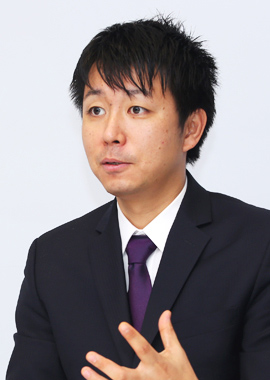
Dr. Fujimaki Although there are several potential approaches by which we might offer services to our users in the near future, we are thinking of using a cloud-type SaaS (Software as a Service) model. The Predictive Analysis Automation Technology platform itself will be employed as a service for users. Also, for customers who have no particular wish to create models themselves, NEC is considering creating in a single day models based on business data that the companies would provide to us. Further, we are also thinking of creating systems by which Predictive Analysis-is Automation Technology might be incorporated into the solutions we offer customers.
Those are sort of patterns we are moving forward on, and we plan to start offering services in Japan and North America within 2017. We would also like to expand further, globally, step by step.
We assume that our initial target users will be large-scale enterprises, but, offering a cloud-based service, we intend eventually to establish an easy-access pathway for small and medium-sized businesses.
Naturally, we are planning further polishing of the technology itself at the same time. One major issue, for example, is expanding the range of data that we can handle, to include such unstructured data as text data. We also want to work toward improved performance. As I noted earlier, with Predictive Analysis Automation Technology, we have already shortened the timeframe for creating a model to within a single day, as compared to the two to three months required by conventional methods. If we could shorten that time to an hour, or to just a single minute, we would be able to provide an entirely different user experience.
Through use of Predictive Analysis Automation Technology, with the value that it provides, NEC intends to continue to contribute to the creation of innovations in the business activities of our users.